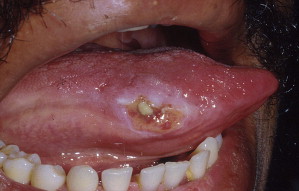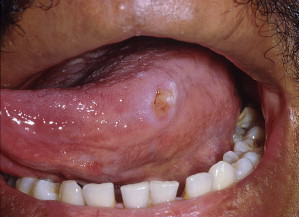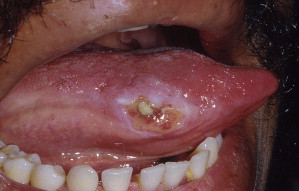Although all dentists are taught about the importance of oral health to general health and that systemic disease can manifest in the oral cavity, the 4-year dental school curriculum does not allow time to gain competency in these relationships. Nevertheless, all dentists must have skills in taking a medical history and an appreciation of oral findings that might have a systemic origin. This article focuses on the identification of abnormal signs and symptoms in the oral cavity and the determination of those that have a systemic origin. It is imperative that clinicians are mindful of the possible oral-systemic associations, because these could potentially have a huge impact on patient care.
Although all dentists are taught about the importance of oral health to general health and that systemic disease can manifest in the oral cavity, time does not exist in the 4-year dental school curriculum to gain competency in these relationships. Nevertheless, all dentists must have skills in taking a medical history and an appreciation of oral findings that might have a systemic origin. These relationships between the mouth and the rest of the body are important for several reasons. First, the astute dental practitioner recognizes an abnormal oral finding and is aware that it could represent an oral manifestation of systemic disease. For example, enlarged gingiva usually represents a local, gingival or periodontal disease process, but this could also represent the first indication of a hematological malignancy from leukemic cell infiltration of the gingiva. Exacerbation of periodontal disease in a patient with Type 1 diabetes is another example. Second, history-taking and other information (eg, laboratory values, physician records and conversations) helps determine the extent to which patients’ medical status allows them to tolerate stressful dental treatment (eg, the patient with unstable angina). The vast majority of medical emergencies in the dental office are avoidable, and they usually stem from not knowing or taking into account the patient’s medical history and current status, and how to modify the dental treatment plan accordingly. Third, patients’ dental status can directly affect their medical status. For example, edentulism results in an inability to masticate food and this has implications for a healthy diet, particularly with regard to nutrition in the elderly or otherwise compromised individuals. Also, patients’ dental status may indirectly affect their medical status. For example, periodontal disease has been proposed as a risk factor for vascular disease.
This article focuses on the identification of abnormal signs and symptoms in the oral cavity and the determination of those that have a systemic origin. It is imperative that clinicians are mindful of possible oral-systemic associations, because they can have an impact on the quality of patient care as mentioned earlier in this section.
Approaches to the diagnosis of systemic disease
The traditional manner of teaching the relationships between oral and systemic disease is focused on an anatomic approach (eg, liver, bone marrow), a disease approach (eg, hepatitis, leukemia), or a drug approach (eg, cancer chemotherapy).
The organ approach focuses on an understanding of human physiology and what happens when organs and organ systems cease to function properly. Once this material is covered, the focus is on the implications for oral disease or abnormal oral findings. The organs most likely to manifest oral findings are the bone marrow, brain, endocrine system, heart, gastrointestinal tract, neuromuscular system, kidneys, and liver ( Table 1 ). The most significant problem with the organ approach to oral disease is that patients do not necessarily know that they have organ disease or malfunction (eg, liver failure) and medical history-taking may not reveal its presence.
| Organ and Organ Systems | Oral Manifestations |
|---|---|
| 1. Bone Marrow/Hematology | Bleeding (petechiae, purpura, hematoma), delayed and/or poor healing, early loss of teeth, mucosal ulcerations, opportunistic infections (bacterial, fungal, viral), pallor |
| 2. Heart | Cyanosis, referred cardiac pain (angina) to the mandible |
| 3. Endocrine | Hyperpigmentation (Addison’s disease), delayed eruption of teeth and enlarged tongue (hypothyroidism), periodontal disease and delayed or poor healing (diabetes) |
| 4. Gastrointestinal | Halitosis, teeth erosion (gastroesophageal reflux disease), ulcerations (Crohn disease) |
| 5. Liver | Bleeding (hematoma, purpura), discoloration of teeth (congenital liver disease), sweet musty odor, yellow pigmentation of mucosa (jaundice) |
| 6. Neuromuscular | Difficulty with swallowing, mastication, speech, deviation of the tongue (facial palsy), drooling, poor oral hygiene and trauma due to poor control of musculature, taste changes |
| 7. Brain | Enamel erosion from bulimia, aphthous ulcers, contribution to ANUG, poor oral hygiene, trauma from self-injurious behavior (eg, cheek/lip/tongue biting), TMD |
| 8. Kidneys | Oral odor, radiographic changes in mandible and/or maxilla, pallor, taste changes, uremic stomatitis |
The disease approach to the relationship between the mouth and systemic disease is similar to the organ approach, focusing on the various diseases that occur with each organ or with multisystem problems. A long list of general disease categories have oral manifestations, including allergy, cancer, and immune suppression ( Table 2 ). As with the organ approach, the problem with this approach is that patients do not always know that they have a systemic disease.
| Oral Findings | Probable Causative Systemic Conditions |
|---|---|
| 1. Altered Mucosa | Erythema and or ulceration: anemia, autoimmune disorders (eg, systemic lupus erythematosus, Behçet syndrome), gastrointestinal conditions (eg, Crohn syndrome), hypersensitivity reactions, medication-induced (eg, nicorandil), self-injurious behaviors (eg, chronic cheek biting), uremic stomatitis, vitamin deficiency |
| Discoloration of oral mucosa: Addison disease, dermatologic diseases, heavy metal poisoning (eg, lead), liver disease, malignancy (eg, melanoma), medication-induced (eg, minocycline, quinolones, oral contraceptives), Peutz-Jeghers syndrome | |
| Oral blisters with or without ulceration: hypersensitivity reactions, vesiculobullous diseases, infections, self-injurious behaviors | |
| Pale oral mucosa: anemia, vitamin deficiency | |
| Xerostomia (subjective) or dry mucosa (objective): diabetes, medication-induced, Sjogren syndrome | |
| 2. Altered Sensation | Anemia, burning mouth syndrome, medication-induced, neuropathies (primary vs secondary causes), opportunistic infections, vitamin deficiency, xerostomia |
| 3. Bleeding | Coagulopathies, medication or disease-induced |
| 4. Musculature | Neurologic: nerve palsy, tardive dyskinesia, poor or defective muscle control causing drooling and accidental trauma |
| Trismus: connective tissue diseases (eg, scleroderma), head and neck irradiation, neoplasm | |
| 5. Odor | Gastrointestinal conditions, respiratory infections, renal failure |
| 6. Opportunistic Infections | Immunosuppression (eg, HIV/AIDS, hematologic malignancies), stress |
| 7. Nondental Pain in the Head and Neck | Medication-induced (eg, vincristine), metastases, neoplasms, neuropathies (eg, primary vs secondary), referred pain (eg, cardiac, musculoskeletal, vascular), sickle cell crisis, temporomandibular disorders |
| 8. Poor Healing | History of high-dose head and neck irradiation, immunosuppression, malnutrition, vitamin deficiency |
| 9. Radiographic Changes in Maxilla and Mandible | Systemic conditions: |
| Bone diseases: osteoarthritis, osteopetrosis, osteoporosis, Paget disease | |
| Connective tissue diseases: rheumatoid arthritis, scleroderma | |
| Genetic syndromes: cherubism, Gardner syndrome, Gaucher disease, Gorlin-Goltz syndrome, McCune-Albright syndrome, Papillon-Lefèvre syndrome | |
| Hematologic disorders: sickle cell anemia, Langerhans cell histiocytosis, thalassemia | |
| Immunosuppression: neutropenia, leukocyte adhesion disease | |
| Malignancies: Langerhans cell histiocytosis, multiple myeloma, metastases | |
| Primary or secondary hyperparathyroidism (from renal disease) | |
| Vascular conditions: carotid artery calcifications, intraosseous hemangioma, arteriovascular malformation | |
| 10. Swelling | Soft tissue: acromegaly, amyloidosis, hemangioma, hypothyroidism, infection, lymphangioma, neoplasm, trauma |
| Hard tissue: acromegaly, bone diseases (eg, Paget disease), hyperparathyroidism, infection, neoplasm, vascular lesions (eg, intraosseous hemangioma) | |
| 11. Teeth | Early loss of primary teeth: acrodynia, hypophosphatasia, histiocytosis X, immunosuppression (eg, cyclic neutropenia), juvenile-onset diabetes mellitus, neoplasms, nutritional deficiency, Papillon-Lefèvre syndrome |
| Discoloration: genetic defects in enamel and dentine formation, hyperbilirubinemia, medication-induced (eg, tetracycline), porphyria | |
| Teeth erosion: eating disorders (eg, bulimia, gastroesophageal reflux disease) | |
| Rampant dental decay: hyposalivation |
The organ and disease approach invariably include a discussion of drugs that have oral manifestations. For example, patients who are receiving intensive cancer chemotherapy or who are taking one of many psychotropic medications frequently have oral manifestations ( Table 3 ).
| Drug Category | Oral Manifestations |
|---|---|
| 1. Anticoagulants | Hematoma, purpura, risk of persistent bleeding after dental procedure or trauma, spontaneous oral bleeding with INR greater than the therapeutic range. |
| 2. Antimicrobials | Black hairy tongue, discoloration of teeth (eg, tetracycline) |
| 3. Antineoplastic Medications | Disturbances in craniofacial and dental development, jaw pain, opportunistic infections, stomatitis, taste changes, xerostomia |
| 4. Antihypertensive Medications | Angioedema, lichenoid changes, stomatitis, taste changes, xerostomia |
| 5. Antipsychotic Medications | Tardive dyskinesia, xerostomia |
| 6. Antiseizure Medications | Bleeding tendencies, phenytoin-induced gingival hyperplasia, pernicious anemia (decreased absorption of vitamin B12) |
| 7. Bisphosphonates (Oral and Intravenous) | Risk for jaw osteonecrosis |
| 8. Calcium Channel Blockers, Cyclosporine, Phenytoin | Gingival enlargement |
| 9. Herbal Medications | Bleeding tendencies (eg, ginger, gingko, garlic, ginseng) |
| 10. Steroids | Moon facies, mucosal atrophy, opportunistic infections |
The problem-oriented approach to identifying systemic diseases and disorders is the most useful from a practical and clinically relevant standpoint. Patients present to the dental office with a concern (subjective) about a change in their mouth or they are found by a member of the dental team to have a visible change in the hard or soft tissues (objective finding). There is a finite list of subjective concerns about the oral cavity that could represent a systemic disease or process. For example, patients can have altered sensation (eg, paresthesia) from a distant malignancy, mucosal ulceration from cancer chemotherapy, or gingival bleeding from an anticoagulant medication. Patients may present to the dental office completely unaware that they have a systemic disease and may be found to have a change in their oral soft tissues. There are various objective indicators of systemic disease, including changes in pigmentation from Addison disease or erythematous mucosa from a drug allergy. Finally, there is considerable overlap in the lists of subjective complaints and objective observations. For example, changes in color of a patch of mucosa (eg, leukoplakia after renal transplantation) may have been noticed by the patient or may first be noticed by a member of the dental team.
Case 1
This 24-year-old non–English-speaking Hispanic man presented unaccompanied to the dental clinic of a large medical center with a chief complaint of nonhealing, bilateral ulcers on his tongue that had been present for about 2 weeks. He had moved to the United States recently from South America with his girlfriend. He denied any medical problems, medications, history of trauma, cough, smoking, or alcohol abuse. Squamous cell cancer, trauma, tuberculosis, and sexually transmitted diseases were on the differential diagnostic list, but all of these possibilities were considered unlikely given the medical history obtained through a translator. On a subsequent visit to the dental clinic 5 days later, the patient’s girlfriend revealed that he had a long history of grand mal seizures. She stated that he refused to take his antiseizure medication and that he had multiple seizures in the past several weeks. He believed that epilepsy was a psychiatric illness, and his cultural background prevented him from admitting to a psychological or psychiatric problem. This case reveals the importance of persistence with the medical history to identify a systemic problem that is manifesting in the oral cavity Figs. 1 and 2 .


Case 1
This 24-year-old non–English-speaking Hispanic man presented unaccompanied to the dental clinic of a large medical center with a chief complaint of nonhealing, bilateral ulcers on his tongue that had been present for about 2 weeks. He had moved to the United States recently from South America with his girlfriend. He denied any medical problems, medications, history of trauma, cough, smoking, or alcohol abuse. Squamous cell cancer, trauma, tuberculosis, and sexually transmitted diseases were on the differential diagnostic list, but all of these possibilities were considered unlikely given the medical history obtained through a translator. On a subsequent visit to the dental clinic 5 days later, the patient’s girlfriend revealed that he had a long history of grand mal seizures. She stated that he refused to take his antiseizure medication and that he had multiple seizures in the past several weeks. He believed that epilepsy was a psychiatric illness, and his cultural background prevented him from admitting to a psychological or psychiatric problem. This case reveals the importance of persistence with the medical history to identify a systemic problem that is manifesting in the oral cavity Figs. 1 and 2 .





